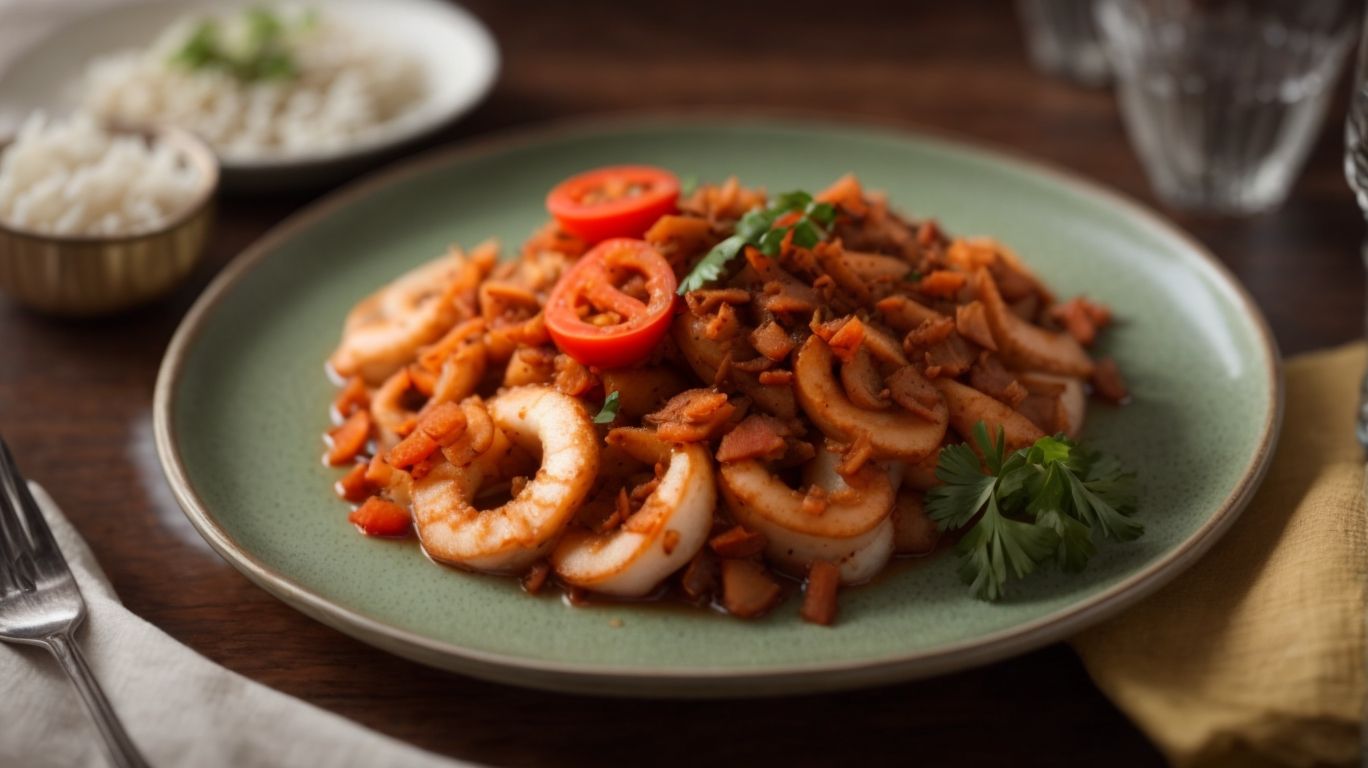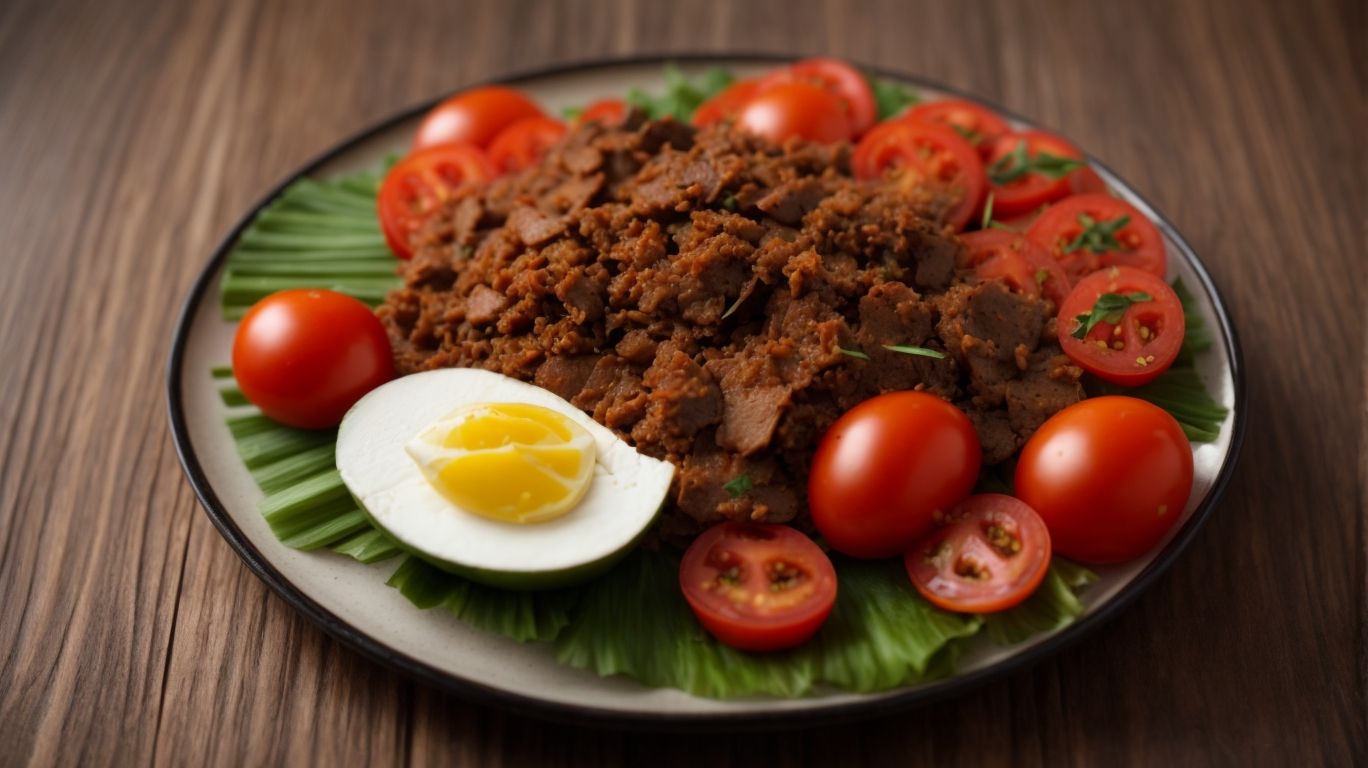How to Cook Adobong Pusit With Kamatis?
Enjoy trying new and delicious Filipino dishes? Learn how to cook Adobong Pusit with Kamatis.
Explore what Adobong Pusit is, the key ingredients needed for this savory dish, how to prepare the squid for cooking, and step-by-step instructions on how to cook Adobong Pusit with Kamatis.
Discover helpful tips and tricks, as well as how to serve and enjoy this flavorful dish. Let’s get cooking!
Key Takeaways:
What is Adobong Pusit?
Adobong Pusit is a classic Filipino dish known for its savory flavors and tender squid cooked in adobo-style sauce, a staple in Filipino cuisine.
This beloved dish holds a special place in Filipino culinary traditions, with its origins tracing back to the rich history of Spanish and Asian influences on Filipino cuisine.
Adobong Pusit, which translates to ‘squid adobo,’ embodies the essence of Filipino comfort food, offering a perfect balance of tangy and savory notes.
The cooking process involves marinating the squid in a mixture of soy sauce, vinegar, garlic, and spices, then simmering it until the flavors meld together, creating a delightful umami-rich dish that is often enjoyed with steamed rice.
What are the Ingredients for Adobong Pusit with Kamatis?

Credits: Poormet.Com – Billy Carter
The ingredients for Adobong Pusit with Kamatis include fresh squid, ripe tomatoes, aromatic garlic, onions, soy sauce, and vinegar, creating a harmonious blend of flavors.
Each ingredient in Adobong Pusit plays a crucial role in enhancing the overall taste and texture of this Filipino dish.
- Fresh squid, the star of the dish, provides a tender and slightly chewy texture, absorbing the savory flavors of the sauce.
- Ripe tomatoes add a subtle sweetness and a burst of freshness, balancing the richness of the squid.
- Aromatic garlic and onions create a flavorful base, infusing the dish with their distinctive taste.
- Soy sauce offers a salty umami depth, while vinegar provides a tangy kick, bringing a zesty contrast to the dish.
Squid
The squid used in Adobong Pusit is a versatile seafood delicacy that serves as the star ingredient, offering a delightful texture and absorbing the rich flavors of the sauce.
Freshness is key when selecting squid for this dish as it ensures a tender and succulent end result. When cleaning squid, remember to remove the cartilage-like backbone and ink sac, taking care to rinse thoroughly. Cooking tip: Searing the squid quickly over high heat helps maintain its firm texture. The squid’s ability to soak up the delectable flavors of the sauce is what makes it a standout in creating a flavorful seafood dish that’s both savory and satisfying.
Tomatoes
Ripe tomatoes in Adobong Pusit contribute a burst of juicy sweetness and vibrant color when sautéed with the squid, enhancing the overall taste and visual appeal of the dish.
During the sautéing process, the tomatoes break down, releasing their natural juices and marrying with the savory flavors of the squid, creating a luscious sauce that coats each tender piece.
This fusion of tastes allows for a rich and robust flavor profile, balancing the slight tanginess of the tomatoes with the earthiness of the squid, resulting in a dish that is both tasty and satisfying.
Garlic and Onion
Garlic and onions form the flavorful base of Adobong Pusit, infusing the dish with aromatic notes and creating a tantalizing aroma when simmered in the cooking pot.
These two essential ingredients not only add depth and richness to the dish but also contribute to its overall complexity of flavors. When preparing them for this traditional Filipino recipe, it is crucial to finely chop the garlic and thinly slice the onions to ensure they distribute evenly throughout the dish.
Sautéing them in the cooking pot until they turn golden brown releases their natural oils and sugars, resulting in a sweet and savory foundation that perfectly complements the tender squid. The sizzling sound of these aromatic ingredients hitting the hot pot is a sign that you are on the right track to achieving a delicious Adobong Pusit.
Soy Sauce and Vinegar
Soy sauce and vinegar are the quintessential ingredients in Adobong Pusit, reflecting the bold flavors of Filipino cuisine and transforming the dish as their combination imparts color changes during cooking.
When simmered together, soy sauce infuses a rich umami depth to the dish, while vinegar adds a tangy kick, balancing the savory notes perfectly. The soy sauce contributes to the darkening of the dish, lending it a deep, caramel hue, while the vinegar helps brighten the flavors and contrasts the richness of the squid. The interplay between these two ingredients creates a complex flavor profile that is both comforting and exciting to the palate, making Adobong Pusit a beloved Filipino favorite.
Other Seasonings (optional)
For those seeking a spicier version, additional seasonings like fish sauce and peppers can be added to Adobong Pusit, lending a fiery kick and depth of flavor to the dish.
When incorporating fish sauce into Adobong Pusit, the umami-rich liquid adds a savory complexity that complements the natural sweetness of the squid. The peppers, whether fresh chili peppers or crushed red pepper flakes, bring a welcomed heat that tantalizes the taste buds without overpowering the delicate seafood flavors. Together, these seasonings create a harmonious balance, elevating the traditional Adobong Pusit into a vibrant, bold dish that is sure to satisfy those craving a fiery culinary experience.
How to Prepare the Squid for Cooking?

Credits: Poormet.Com – Zachary Scott
To prepare the squid for cooking, it is essential to clean and slice the squid into desired pieces, marinating them in a mixture of coconut milk (gata) and selected seasonings for a specified cooking time.
After cleaning and slicing the squid, the next step is marinating them in a delicious blend of coconut milk, which adds a creamy richness, and seasonings to enhance the flavors. Cooking time plays a crucial role as it allows the squid to absorb the flavors fully. For best results, marinate the squid for at least 30 minutes to 1 hour, ensuring that every piece is coated evenly. This soaking period ensures a tender texture and a flavorful outcome, making your dish truly satisfying.
How to Cook Adobong Pusit with Kamatis?

Credits: Poormet.Com – Bobby Mitchell
Cooking Adobong Pusit with Kamatis involves sautéing the garlic, onions, squid, and tomatoes, then simmering the mixture in a delectable coconut sauce until the flavors meld perfectly, resulting in a delicious dish.
Once the fragrant aroma of the sautéed ingredients fills the kitchen, it’s time to introduce the creamy coconut sauce into the pan. This rich sauce not only adds depth to the dish but also brings a subtle sweetness that complements the savory flavors of the seafood and vegetables. As the mixture simmers gently, the sauce thickens, enveloping every piece of squid and tomato in its luscious embrace.
Sautéing the Garlic and Onion
Start by sautéing garlic and onions in a cooking pot over medium heat, allowing the aromatics to release their flavors and provide essential nutrition information for a balanced meal.
This process of sautéing these key ingredients on medium heat is crucial as it helps to develop rich flavors while retaining the nutritional value of the garlic and onions. The gentle heat allows the natural sugars in the vegetables to caramelize, enhancing the overall taste of the dish. By cooking them on medium heat, you can prevent burning and ensure a perfectly balanced blend of flavors in your meal.
Adding the Squid and Tomatoes
Add the prepared squid and tomatoes to the sautéed mixture, observing the color changes as the ingredients combine harmoniously, and serve the finished dish with steamed rice for a fulfilling meal.
When incorporating squid and tomatoes into the sautéed mixture, keep an eye on the transformation of colors; the squid turns opaque and firm while the tomatoes soften and release their juices, creating a vibrant dish.
Once the colors have shifted, indicating the readiness of the meal, pair it with a generous serving of fluffy steamed rice to soak up the delicious flavors.
Pouring the Soy Sauce and Vinegar Mixture
Pour the soy sauce and vinegar mixture over the ingredients, allowing the flavors to meld and the dish to cook through in a fragrant blend of oil, ensuring that the squid is thoroughly cooked and infused with the rich sauce.
As the soy sauce and vinegar combine, their umami flavors seep into every crevice of the squid, enhancing its natural taste and texture. The key is to cook it just long enough – not overdone nor undercooked – so that each piece is tender and succulent. The fragrant oil not only permeates the dish with its enticing aroma but also helps to evenly coat the squid, letting it soak up all the savory goodness of the sauce.
Simmering and Adding Seasonings
Simmer the mixture in a coconut sauce, allowing the flavors to meld and intensify, while adjusting seasonings like vinegar briefly to achieve the desired taste balance with other ingredients in the dish.
Simmering the ingredients in a coconut sauce is a crucial step in many flavorful dishes, especially those with an Asian or tropical influence. This process allows the rich and creamy coconut flavors to permeate throughout the dish, creating a harmonious blend of tastes and aromas.
Regarding adjusting the seasonings, a touch of vinegar can work wonders in balancing out the richness of the coconut sauce. Vinegar adds a subtle acidity that can cut through the richness, providing a refreshing contrast that elevates the overall flavor profile.
Tips for Cooking Adobong Pusit with Kamatis
For a successful preparation, ensure you use a sturdy cooking pot and taste the dish throughout the cooking process to adjust seasoning levels for a delicious outcome that captures the essence of Adobong Pusit.
Choosing the right cooking vessel is crucial for even heat distribution, ensuring every piece of squid is perfectly cooked. A heavy-bottomed pot will prevent scorching and allow the flavors to meld beautifully.
Remember, not all pots are created equal! Opt for a non-reactive material like stainless steel or enamel to avoid any metallic taste affecting the dish.
As you simmer the squid in its savory marinade, take small spoonfuls to taste, adjusting the seasoning with salt and pepper as needed. This step is where you can truly personalize the dish to your taste preferences.
How to Serve and Enjoy Adobong Pusit with Kamatis?

Credits: Poormet.Com – Gary Baker
To serve and enjoy Adobong Pusit with Kamatis, plate the dish alongside steamed rice, drizzling extra sauce over the squid, and offer fish sauce as a condiment for enhanced flavor customization.
Adobong Pusit with Kamatis is a delightful combination of tender squid cooked in a savory sauce with the tanginess of tomatoes, creating a mouth-watering Filipino dish. The subtle sweetness of the squid perfectly complements the acidity of the tomatoes, making each bite a burst of flavors. Pairing this dish with steamed rice is a classic choice, allowing the rich sauce to be soaked up by the fluffy grains, enhancing the overall dining experience.
For those who enjoy a bit more moisture in their dishes, consider preparing a small bowl of extra sauce to drizzle over the squid and rice. This infusion of flavors will further intensify the taste profile and keep the dish from becoming dry. Offering fish sauce on the side allows each diner to adjust the saltiness level according to their individual preferences, creating a personalized dining experience.
Conclusion
In conclusion, Adobong Pusit with Kamatis is a delightful dish that showcases the vibrant colors of fresh ingredients and ensures the squid is cooked through to perfection, offering a flavorful culinary experience.
The distinct blend of rich dark ink, the bright red hue of tomatoes, and the tender white flesh of the squid simmered together create a visually appealing sight on the plate.
Cooking the squid thoroughly is crucial to achieving the ideal texture and unlocking the full depth of flavors. Once the dish is cooked just right, the tender squid combined with the tangy tomato sauce results in a mouthwatering dish that is a feast for the senses.
Frequently Asked Questions
What ingredients do I need to cook adobong pusit with kamatis?
To make adobong pusit with kamatis, you will need squid, tomatoes, garlic, onions, vinegar, soy sauce, and black pepper.
Do I need to clean the squid before cooking?
Yes, it is important to clean the squid before cooking. Remove the head, ink sac, and internal organs. Rinse the squid thoroughly under cold water.
How do I prepare the squid for cooking?
After cleaning the squid, cut it into small pieces and score the flesh with a knife to create a criss-cross pattern. This will help the squid absorb the flavors of the adobo sauce.
What is the cooking time for adobong pusit with kamatis?
The cooking time for adobong pusit with kamatis is around 20 minutes. It is important to cook the squid until it is tender, but not overcooked.
Can I use other types of vinegar for this dish?
Yes, you can use other types of vinegar such as cane vinegar or apple cider vinegar. However, the traditional Filipino adobo recipe calls for white vinegar.
What are some serving suggestions for adobong pusit with kamatis?
Adobong pusit with kamatis is best served with steamed rice. You can also serve it with vegetables on the side, such as sautéed bok choy or green beans.





